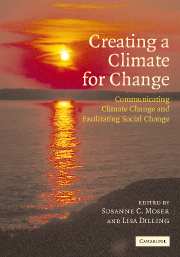Book contents
- Frontmatter
- Contents
- Preface
- Foreword
- List of contributors
- List of tables
- List of figures
- List of text boxes
- Introduction
- Part I Communicating climate change
- Part II Facilitating social change
- 15 Stuck in the slow lane of behavior change? A not-so-superhuman perspective on getting out of our cars
- 16 Consumption behavior and narratives about the good life
- 17 Educating for “intelligent environmental action” in an age of global warming
- 18 Education for global responsibility
- 19 Changing the world one household at a time: Portland's 30-day program to lose 5,000 pounds
- 20 Changing organizational ethics and practices toward climate and environment
- 21 Change in the marketplace: business leadership and communication
- 22 The market as messenger: sending the right signals
- 23 Making it easy: establishing energy efficiency and renewable energy as routine best practice
- 24 Forming networks, enabling leaders, financing action: the Cities for Climate Protection™ campaign
- 25 Ending the piecemeal approach: Santa Monica's comprehensive plan for sustainability
- 26 States leading the way on climate change action: the view from the Northeast
- 27 West Coast Governors' Global Warming Initiative: using regional partnerships to coordinate climate action
- 28 Building social movements
- 29 Climate litigation: shaping public policy and stimulating debate
- 30 The moral and political challenges of climate change
- Part III Creating a climate for change
- About the authors
- Index
- References
25 - Ending the piecemeal approach: Santa Monica's comprehensive plan for sustainability
Published online by Cambridge University Press: 20 August 2009
- Frontmatter
- Contents
- Preface
- Foreword
- List of contributors
- List of tables
- List of figures
- List of text boxes
- Introduction
- Part I Communicating climate change
- Part II Facilitating social change
- 15 Stuck in the slow lane of behavior change? A not-so-superhuman perspective on getting out of our cars
- 16 Consumption behavior and narratives about the good life
- 17 Educating for “intelligent environmental action” in an age of global warming
- 18 Education for global responsibility
- 19 Changing the world one household at a time: Portland's 30-day program to lose 5,000 pounds
- 20 Changing organizational ethics and practices toward climate and environment
- 21 Change in the marketplace: business leadership and communication
- 22 The market as messenger: sending the right signals
- 23 Making it easy: establishing energy efficiency and renewable energy as routine best practice
- 24 Forming networks, enabling leaders, financing action: the Cities for Climate Protection™ campaign
- 25 Ending the piecemeal approach: Santa Monica's comprehensive plan for sustainability
- 26 States leading the way on climate change action: the view from the Northeast
- 27 West Coast Governors' Global Warming Initiative: using regional partnerships to coordinate climate action
- 28 Building social movements
- 29 Climate litigation: shaping public policy and stimulating debate
- 30 The moral and political challenges of climate change
- Part III Creating a climate for change
- About the authors
- Index
- References
Summary
One thing is clear: the fate of cities will determine more and more not only the fate of nations but also of our planet. We can afford to ignore the issue of the sustainable management of our cities only at our own peril.
Elizabeth Dowdeswell (1996), former United Nations Under-Secretary General and Executive Director, United Nations Environment ProgrammeOne California city has made an unblinking appraisal of its fate, and created a comprehensive plan for sustainability. It's a blueprint that links climate change with other environmental issues, economic development, and social equity – all in the larger context of the community's quality of life. Certainly, the effects of climate change already touch the ocean-front municipality of Santa Monica where sea-level rise sends higher-than-historical winter storm waves surging against the base of the Sustainable City Program office, and these effects will continue to change other aspects of life. Extended heatwave days, for example, could dramatically increase the risks to human health (Hayhoe et al., 2004a, b). Yet rather than just focus on energy use and emissions, Santa Monica has chosen a systems approach, addressing climate change with strategies aimed at its cultural and physical causes.
Surrounded on three sides by Los Angeles County, the pint-sized municipality of Santa Monica – just 8.3 square miles on the map, but with global vision – has consistently been at the leading edge of a movement for sustainable cities.
- Type
- Chapter
- Information
- Creating a Climate for ChangeCommunicating Climate Change and Facilitating Social Change, pp. 399 - 415Publisher: Cambridge University PressPrint publication year: 2007
References
- 1
- Cited by



